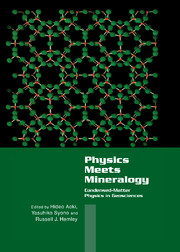Book contents
- Frontmatter
- Contents
- Preface
- List of Contributors
- Part I Introduction
- Part II Advances in Theoretical and Experimental Techniques
- Part III New Findings in Oxides and Silicates
- Part IV Transformations in Silica
- Chapter 4.1 Polymorphism in Crystalline and Amorphous Silica at High Pressures
- Chapter 4.2 Shock-Induced Phase Transitions of Rutile Structures Studied by the Molecular-Dynamics Calculation
- Chapter 4.3 Lattice Instabilities Examined by X-ray Diffractometery and Molecular Dynamics
- Chapter 4.4 Effect of Hydrostaticity on the Phase Transformations of Cristobalite
- Part V Novel Structures and Materials
- Part VI Melts and Crystal–Melt Interactions
- Subject Index
- Materials Formula Index
- Index of Contributors
Chapter 4.1 - Polymorphism in Crystalline and Amorphous Silica at High Pressures
Published online by Cambridge University Press: 05 November 2011
- Frontmatter
- Contents
- Preface
- List of Contributors
- Part I Introduction
- Part II Advances in Theoretical and Experimental Techniques
- Part III New Findings in Oxides and Silicates
- Part IV Transformations in Silica
- Chapter 4.1 Polymorphism in Crystalline and Amorphous Silica at High Pressures
- Chapter 4.2 Shock-Induced Phase Transitions of Rutile Structures Studied by the Molecular-Dynamics Calculation
- Chapter 4.3 Lattice Instabilities Examined by X-ray Diffractometery and Molecular Dynamics
- Chapter 4.4 Effect of Hydrostaticity on the Phase Transformations of Cristobalite
- Part V Novel Structures and Materials
- Part VI Melts and Crystal–Melt Interactions
- Subject Index
- Materials Formula Index
- Index of Contributors
Summary
Recent years have been witness to advances in our understanding of the high-pressure behavior of crystalline and amorphous silica. Experimental developments made possible by new diffraction techniques have generated new findings to megabar pressures (i.e., above 100 GPa). Theoretical advances, including increasingly accurate first-principles methods and interatomic potentials such as those first proposed by Yoshito Matsui and co-workers, have provided predictions and new understanding of experimental data. We review these theoretical developments in the context of recent experimental findings. Our analyses provides a basis for understanding the extensive metastablity of high-pressure crystalline structures, the nature of the short- and intermediate-range order of the high-pressure amorphous material, and both equilibrium and nonequilibrium transformations. Such study also provides insight into the structural basis of anomalous transport properties of the liquid predicted at high pressure.
Introduction
The nature of silica under pressure is a textbook example of the intersection of condensed-matter physics and mineralogy [1]. Silica is of obvious importance in mineralogy, as SiO2 is abundant in the Earth's crust and plays a major role in the deep interior, both as a product of chemical reactions and as an important secondary phase. From the point of view of condensed-matter physics, SiO2 presents an important system for investigating pressure-induced polymorphism, providing examples of first-order reconstructive transitions [2], displacive (soft-mode-driven) transitions [3], pressure-induced amorphization [4, 5], and polymorphism and polyamorphism [4–6]. Silica is also of great technological interest in both its crystalline and glassy forms.
- Type
- Chapter
- Information
- Physics Meets MineralogyCondensed Matter Physics in the Geosciences, pp. 173 - 204Publisher: Cambridge University PressPrint publication year: 2000
- 6
- Cited by

